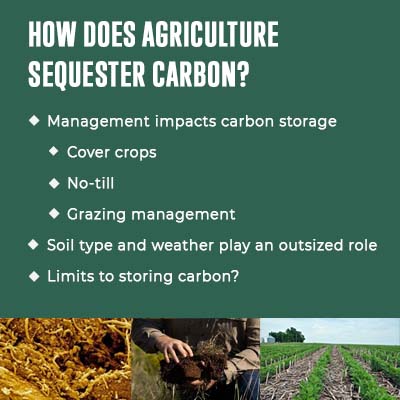Frontier Farm Credit and Farm Credit Services of America (FCSAmerica) are co-sponsoring a webinar series, Two Economists and a Lender. In this episode, the carbon market is discussed by economists David Widmar and Brent Gloy. Myriah Johnson, our vice president of Corporate Sustainability, provides background on the carbon market, agriculture’s role in sequestering carbon and opportunities to sell carbon credits to companies looking to offset pollution. Below is an overview of the conversation.
Carbon Market Definitions
Carbon Credit – A tradeable permit or certificate that provides the holder of the credit the right to emit one ton of carbon dioxide or an equivalent of another greenhouse gas.
Carbon Inset –Implementation of sustainable practices that sequester carbon.
Carbon Offset – Investment in practices that reduce carbon emissions elsewhere to compensate for your carbon footprint.
Additionality – Offset is created for something that wouldn’t have been done otherwise.
Permanence – An offset that is created and can’t be easily undone.
Verifiable – The offset can be measured and verified.
Much of the current climate change discussion deals with getting carbon out of the atmosphere and back down in the soil. Agriculture is the one industry that deals directly with soil and has the capacity to influence the movement of carbon from the atmosphere into the soil. Of course, we can’t control it completely. We know weather can play a huge role in this effort. In some ways, weather almost dwarfs our influence as land managers. But that's not to say we're not going to try.
 A variety of land management practices can help us achieve sequestration. The image - how does agriculture sequester carbon - only cites a few. Cover crops and reduced tillage probably are among the most familiar. Grazing management practices also can influence carbon storage on pasture and grassland.
A variety of land management practices can help us achieve sequestration. The image - how does agriculture sequester carbon - only cites a few. Cover crops and reduced tillage probably are among the most familiar. Grazing management practices also can influence carbon storage on pasture and grassland.
While we understand the practices that contribute to sequestration, there is much we don’t know, including how fast we can store carbon and for how long. The uncertainty around carbon storage contributes to some of the uncertainty we see in the carbon marketplace and the struggle to get it up and running. That hasn’t stopped investment in the industry or buyers.
Carbon buyers are companies that have committed to reduce their emissions. An airline, for example, may have announced it will reduce its carbon footprint to zero. But alternative fuels can only go so far in achieving that goal, so the airline buys carbon credits – one ton of sequestered carbon for one ton of emitted carbon – to get it closer to its target.
From the perspective of an agricultural producer, a carbon credit is just another commodity. But getting it from field to market requires certification. Middlemen will test carbon in the soil to verify it has been sequestered. Once certified, a credit goes into a carbon registry, where it can be sold as an inset or offset, but not both. This paper trail ensures a carbon credit is sold only once.
How to Evaluate the Sale of Carbon Credits
The sale of a carbon credit is, in many ways, the same as any other commodity. Think of corn. If you were offered $7 a bushel, would you take it? That’s probably not enough information on which to make a decision. You also would want to know things such as how many bushels are required and at what level of quality, when and where must it be delivered, what are the payment terms . . . ? When producers have the opportunity to sell carbon credits, it is just as important to step back and assess all the requirements. The sale of corn is more intuitive to most producers than the sale of carbon credits, so it’s important to spend time learning about the market and its various opportunities. If producers only consider the one opportunity in front of them and allow that to drive their thought process, they could miss the bigger picture and lock themselves into a contract that isn’t the best deal for them. The goal is to be in the driver seat, to think strategically. Writing down key questions and the answers you have arrived at is an effective tool for decision-making. Also capture the thinking of family members, employees and other trusted advisors. It’s important to revisit your answers; it can reveal how your thinking has changed over time and where there are weaknesses or blind spots.
Here are some questions to get you started:
- What are your current thoughts and expectations regarding carbon credits? Do you see it as an exciting opportunity, think it could change the world and has no downside or are you skeptical about the market and what it can accomplish?
- What would cause you to change your mind? If it’s information, what would that be and is it available? Will it be the future?
- Is there a significant management burden to entering the carbon market?
- Can you enter the carbon market in increments – say just a few acres -- to get familiar with it?
The time invested today in answering these and other questions will pay off when opportunity presents itself. It’s important to be realistic about what the market and its opportunities and understand what you want and need to get from it.
Watch the full webinar recording from August 25 below. Explore past and upcoming webinars

